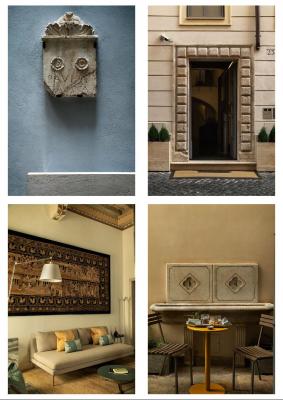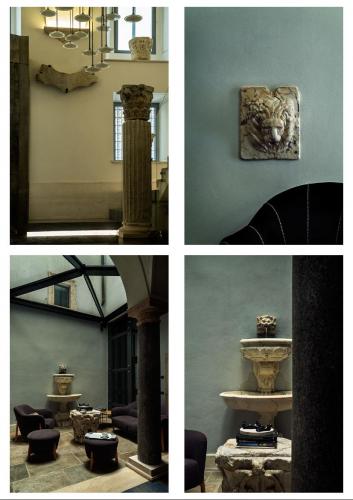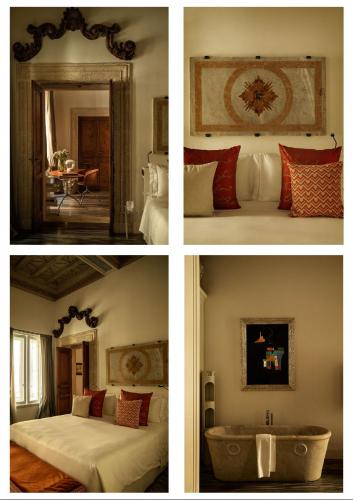Preserving Italian culture through historic renovation at Palazzo delle Pietre

ROME -- You can now experience Italian history from the intimacy of your own luxury service apartment. That is the approach taken by Mazzi family, who have carefully restored two ancient buildings, the Palazzo delle Pietre, and La Corte, both within a stone’s throw from Piazza Navona and the Pantheon. Palazzo delle Pietre is a pre-15th century palace located on the Via delle Coppelle, an ancient Roman thoroughfare, in one of the densest and most complex areas of the historical fabric of the Eternal City.
The foundations sit on the ruins of the Terme Alessandrine, a thermal bath complex built by Nero in AD 62 and purportedly still in use up until the 5th century AD. Once owned by Vatican Arciconfraternita della SS Annunziata, it had by the 15th century and up until the 19th century been expropriated by the Vatican to house a charitable arm, before emerging in the postwar 20th century as an apartment block.
Acquired by the Mazzi family in 2012, and following seven years of restoration in collaboration with mp2a Architetti Associati, the historic palace has been carefully restored to offer eight lavish rental apartments. Curated by engineer Carlo Mazzi, with his wife Patrizia and daughter Barbara, the family worked as archaeologists, conservationists and future-proofers in collaboration with the Superintendence of Cultural Heritage to preserve, restore, elevate and gift the palace back to the capital for future generations.
Upon restoration, frescoes were found behind wallpapers; stone epigraphs, sculptures and porticos were revealed when demolishing fake walls and peeling back plaster; and two original windows appeared from behind recent masonry. Other historic architectural features include antique poplar doors with travertine marble portals, and original beamed and vaulted ceilings with the original decorations that have been expertly restored.
Approaching from the cobblestone street, the Palazzo reception is a serene contrast to the bustling Via delle Coppelle. Sumptuous dark grey marble suffused by natural silver and sapphire veins lines the floor of the reception, reflecting the Artemide chandelier. Artefacts, many inherited from Carlo’s great-great grandfather, are thoughtfully arranged throughout the communal and residential spaces, and span the Imperial Roman (1st century BC and 3rd century AD), Romanesque, Renaissance periods to the contemporary. In the natural light of the ground floor conservatory, guests will discover a Renaissance fountain, a fragment of Roman relief entablature and a 2nd century Corinthian capital ingeniously repurposed as a coffee table encircled by seating by designers De Padova.’ll>
The apartments are entered through an armoured entrance door, each painted a different colour, helping to orient guests. Each apartment boasts a unique selection of antiquities - Renaissance and baroque furniture, fragments of ancient sculptures, busts, masks, a 17th century carved frieze, a 2nd century breccia marble column, epigraphs, travertine portals and even a Napoleonic-era marble bathtub. Each apartment includes a fully equipped kitchen area, with cutlery from Sambonet, and accessories from Mario Luca Giusti and Alessi.
The spaces are adorned with a mix of antique parquet flooring and precisely book-matched opulent marble either reclaimed or from the prestigious Antolini. Great care has been paid to selecting furniture and furnishings with sumptuous fabrics that complement the historic features. Furnishings have been selected from antique dealers across Italy, augmenting more modern pieces by designers such as Alivar, Kartell, Richard Ginori, De Padova, and Danese, showcasing the best of modern Italian design.
The Palazzo offers guests modern amenities such as a fitness centre, and a marble and mosaic clad spa treatment suite. The family have created a unique communal organisation within the Palazzo for cultural exchange, the FraMmenti Club - a space for discussion, research, training, celebration and the exploration of new ideas. Its programme spans history, urbanism, the arts, science and literature. This in-house cultural salon aspires to catalyse interdisciplinary relationships, bringing together guests and invited luminaries. The FraMmenti Club, Barbara explains, “fully reflects the 'philosophy' of the building which is the love for beauty and culture, for art and for knowledge that must be shared”.
For their inaugural exhibition (2020-2021), The FraMmenti Club, in collaboration with Galleria La Sinopia, invited the work of contemporary sculptor Riccardo Monachesi (Rome, b.1977). The exhibition of 34 works was entitled “Pietra formata”, a nod to the building’s namesake. Since then, the club has curated many events, including a meeting with film costume designer Carlo Poggioli, environmental researcher Fabio Attorre and Director of Civic Museums, Professor Ilaria Miarelli Mariani. Visitors can expect more wonderful events in the future.
Just a few steps from the Palazzo lies the sister complex, Appartamenti La Corte, which has been developed to the same high standard as the Palazzo. The penthouse suite offers a large private rooftop terrace, and such a spectacular amenity is hard to come by in Rome’s historic centre.
The Mazzi’s vision and execution of the Palazzo delle Pietre and Le Corte are a reverential tribute to the Eternal City, creating a beautiful cultural space to both live and learn in. It is a masterful preservation of a cultural and historic Roman building for future generations, and as such, rightly has become a member of the Italian Historic Houses Association.
jp-hl


© COPYRIGHT ITALIAN INSIDER
UNAUTHORISED REPRODUCTION FORBIDDEN


